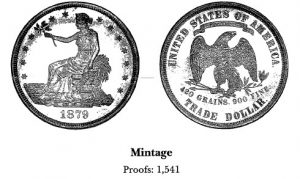Ultra-Rare US Trade Dollar: Coin History
Posted on — 3 CommentsIn the late 1860s and early 1870s trade between the U.S. and China was increasing. However, a threat to this trading emerged from the unlikeliest of places; the Mexican peso.
 *
*
Many Chinese businesses preferred the peso to U.S. currency because the peso contained more silver than the standard U.S. dollar. This characteristic of business abroad meant that U.S. businesses had to exchange their dollars for pesos which generated costly broker fees. The government’s answer to this problem was the US trade dollar.
The U.S. started to mint trade dollar coins in 1873. The trade dollar consisted of 90% silver and weighed slightly more than the peso (420 grains vs. 416). During the first two years of production the U.S. sent nearly all the minted coins abroad to ease trade problems. Soon after, they granted the coins the status of legal tender domestically.
The trade dollar was a success abroad. Chinese businesses embraced the coin and preferred its heavier weight over the peso. Chinese merchants often put a “chop” mark on their U.S. trade dollars. These punched Chinese characters indented on the surface of the coin were likely a method for testing the authenticity of the piece. As the coin passed from one merchant to another it would occasionally receive multiple chop marks.
In time, demand for the US trade dollar surged. However, mining activity at home altered the course of history for the trade dollar.
U.S. mines in the western regions of the country were yielding enormous amounts of silver. This influx of precious metal disrupted the supply and demand dynamics in the market. Silver prices plummeted. As a result, the trade dollar fell to an intrinsic value of just 80 cents. Soon after, the U.S. saw large amounts of trade dollars flow back into the country where Americans spent the coins at their face value. In response, Congress acted and revoked the coin’s status as legal tender in July of 1876. They continued to mint the coin, but only for the purpose of exportation.
Just two years later, Treasury Secretary John Sherman ended production of trade dollar coins. However, from 1879 forward, the Treasury issued proof strikes expressly for collectors. Eventually, in early 1887, legislators passed a law allowing those holding U.S. trade dollars to redeem their coins. This act brought approximately 8 million U.S. trade dollars back into the government’s hands.
With the passing of the Coinage Act of 1965, trade dollars became legal tender once more. Today, the coins are highly sought after by collectors. The 1884 and 1885 trade dollars are considered to be the rarest of these desirable coins. Prior to 1908, these coins were not known to exist. Officials and collectors learned that ten proofs dated 1884, and five proofs dated 1885 were minted. The production of these extra pieces was not recorded in official records. In 2006, a collector purchased an 1885 U.S. trade dollar in a private transaction for $3.3 million.
Collectors often use extra scrutiny when collecting trade dollar coins as their rarity, value, and history make them a prime target for counterfeiters.
*Image courtesy of PCGS
3 thoughts on “Ultra-Rare US Trade Dollar: Coin History”
Comments are closed.








Recently, I’ve been looking at trade dollars on line after ignoring them for years. I’ve noted that some of the later dated coins (82,83) have extremely low manages of about 100 proof only pieces. Despite this incredibly low montage they are priced at $2 to 4 or 5 thousand per coin at middle proof grades. Other coins with this level of montage would be priced in the tens of thousands and more. Any ideas how this situation has occurred? Thanks.
I’ve got a beautiful 1886 coin I really don’t know about coins but it’s for sale
We’d suggest you take your coin to a reputable coin dealer in your area for more information on it’s value and story.